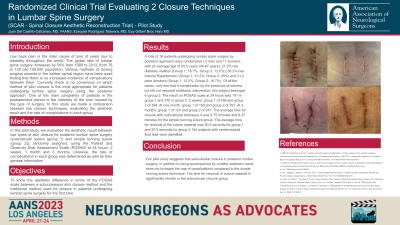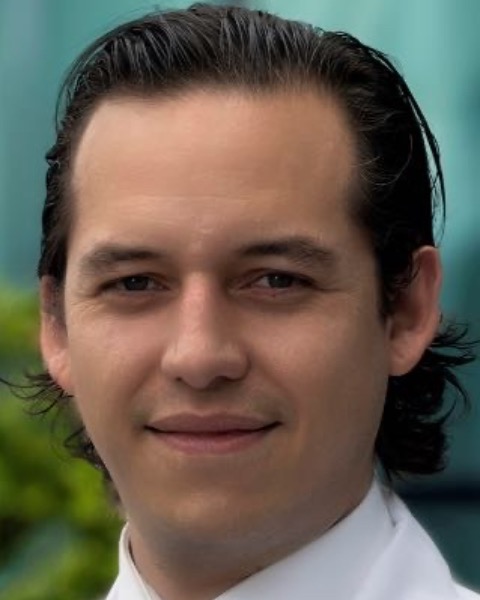Randomized Clinical Trial Evaluating 2 Closure Techniques in Lumbar Spine Surgery (SCAR - Spinal Closure Aesthetic Reconstruction Trial) - Pilot Study
Friday, April 21, 2023

Has Audio

Juan Del Castillo Calcaneo, MD, FAANS (he/him/his)
Neurosurgery and spine surgery consultant/Associate Profesor of Neurosurgery and Spine
ISSSTE / ABC Medical Center
Mexico City, DF, Mexico
ePoster Presenter(s)
Introduction: Low back pain is the main cause of loss of years due to disability throughout the world. The global rate of lumbar spine surgery increased by 54% from 1999 to 2013, from 78 to 120 per 100,000 population. Various methods of closing surgical wounds in the lumbar spinal region have been used finding that there is no increased incidence of complications between them. Currently, there is no consensus on which method of skin closure is the most appropriate for patients undergoing lumbar spine surgery using the posterior approach.
Methods: In this pilot study, we evaluated the aesthetic result between two types of skin closure for posterior lumbar spine surgery (subcuticular suture (group 1) and simple running suture (group 2)), randomly assigned, using the Patient and Observer Scar Assessment Scale (POSAS) at 24 hours, 2 weeks, 1 month and 3 months. Likewise, the rate of complications in each group was determined as well as their general information.
Results: A total of 10 patients undergoing lumbar spine surgery by posterior approach were randomized (5 men and 5 women), with an average age of 60.7 years (40-73 years). The result on the POSAS scale at one month was for group one 107 and group two 188. At 3 months: group one of 90 and group two of 159. The average time for closure with subcuticular technique it was 10.4 minutes and 8.8 minutes for the simple running suture group. The average time for removal of the suture material was 10 seconds for group 1 and 72 seconds for group 2. No subjects with cerebrospinal fluid leak were identified.
Conclusion : Our pilot study suggests that subcuticular closure in posterior lumbar surgery, in addition to being accompanied by a better aesthetic result, does not increase the rate of complications compared to the simple running suture technique.
Methods: In this pilot study, we evaluated the aesthetic result between two types of skin closure for posterior lumbar spine surgery (subcuticular suture (group 1) and simple running suture (group 2)), randomly assigned, using the Patient and Observer Scar Assessment Scale (POSAS) at 24 hours, 2 weeks, 1 month and 3 months. Likewise, the rate of complications in each group was determined as well as their general information.
Results: A total of 10 patients undergoing lumbar spine surgery by posterior approach were randomized (5 men and 5 women), with an average age of 60.7 years (40-73 years). The result on the POSAS scale at one month was for group one 107 and group two 188. At 3 months: group one of 90 and group two of 159. The average time for closure with subcuticular technique it was 10.4 minutes and 8.8 minutes for the simple running suture group. The average time for removal of the suture material was 10 seconds for group 1 and 72 seconds for group 2. No subjects with cerebrospinal fluid leak were identified.
Conclusion : Our pilot study suggests that subcuticular closure in posterior lumbar surgery, in addition to being accompanied by a better aesthetic result, does not increase the rate of complications compared to the simple running suture technique.
